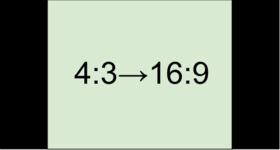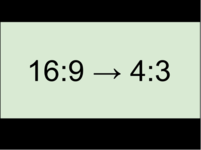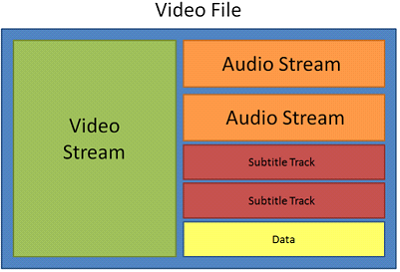|
|
Glossary
Here's a list of some terms that you may come across while working with video and audio. You don't need to know all of these to use Movavi software, but if you want to learn more about the specifics of media file processing, you can start here.
Aspect ratio
A video's aspect ratio is the proportion of its width to its height (e.g., 16:9; read as sixteen by nine). You will usually encounter the 16:9 or 4:3 aspect ratios, but most recent displays and videos have a 16:9 aspect ratio. You might encounter 4:3 resolutions in older TV videos. Here's how they look:

If you join videos with different aspect ratios, you might see black bars on the sides. Think of a video's frame like a box: If you put a square peg into a rectangular hole, you will have room left over on the sides. This can happen in your project if you're mixing videos and photos or if you're using videos from different sources. This is what it might look like if you add 4:3 videos to a 16:9 project and vice versa:


Learn more:
Bitrate
Bitrate is a property of digital video and audio files. It determines the amount of data in bits contained in each second of the video or audio. Higher bitrates allow the preservation of more detail but also require more disk space for the output file. The bitrate also depends on your video resolution because you need much more data to store a large HD video frame compared to a tiny 360p video. If your video contains lots of small details or fast action, you can choose a higher quality when exporting your project. The output video will have a larger file size, but you'll be able to see more details.
Codec
Video and audio information is processed, or encoded, to shrink the file size. However, your computer needs to have a decoder installed to open the file. There are many codecs, each compressing video in different ways. Many video formats can store multiple video formats. For example, you can save a video with the .mp4 extension, but you can use the H.264 or MPEG-4 codecs. If you don't know what codec works best for you, go with H.264; it is supported by most players and platforms.
Tip: Don't download codecs from suspicious websites. They may contain malware.
Format
When talking about formats, we usually mean container formats, namely, the way of storing a video or audio track's information inside a file. You can tell container formats by their file extensions. A container format contains video and audio streams, which are encoded with a codec. The figure below schematically shows the components of a video file.

Frame rate (FPS)
A video's frame rate is the number of frames, or still images, in each second of the video (also called FPS, or frames per second). Most movies have a rate of 24 frames per second, but most cameras and cell phones shoot videos at 30 frames per second. More modern cameras even allow you to film at 60 FPS or higher. If you have a high frame rate, you can slow down the video to create a slow-motion effect without making the video look choppy.
*.mepb files
Movavi Video Editor project files are saved with the .mepb extension. You can open the file in the Editor and continue working on your project. If you upgrade to the Plus version, you will need to save the project file as an MEPX project.
*.mepx files
Movavi Video Editor project files are saved with the *.mepx extension. You can open the file in the Editor and continue working on your project.
A video's resolution is basically its width and height in pixels. It is usually written as width × height (e.g., 1280 × 720), but sometimes you might only see the height (e.g., 720p). Videos with a higher resolution usually have better quality because there are more pixels available for storing information. However, if you convert a low-quality video to a higher resolution, it will not look better because there is nowhere to restore extra information from, so you will end up with the same quality at a much larger file size. You can change the resolution of your output video in project settings.
Sample rate
The sample rate affects the quality of digital sound and determines the highest frequency that an audio stream can contain. The default sample rate is 44100 Hz, which exceeds the highest frequency humans can perceive and is used to record audio CDs and most music tracks.
Stream
A video file contains the video and audio information in separate streams, which simply means that their data is stored separately inside the file. When you play the file, these streams are played simultaneously, just like streams of water.


